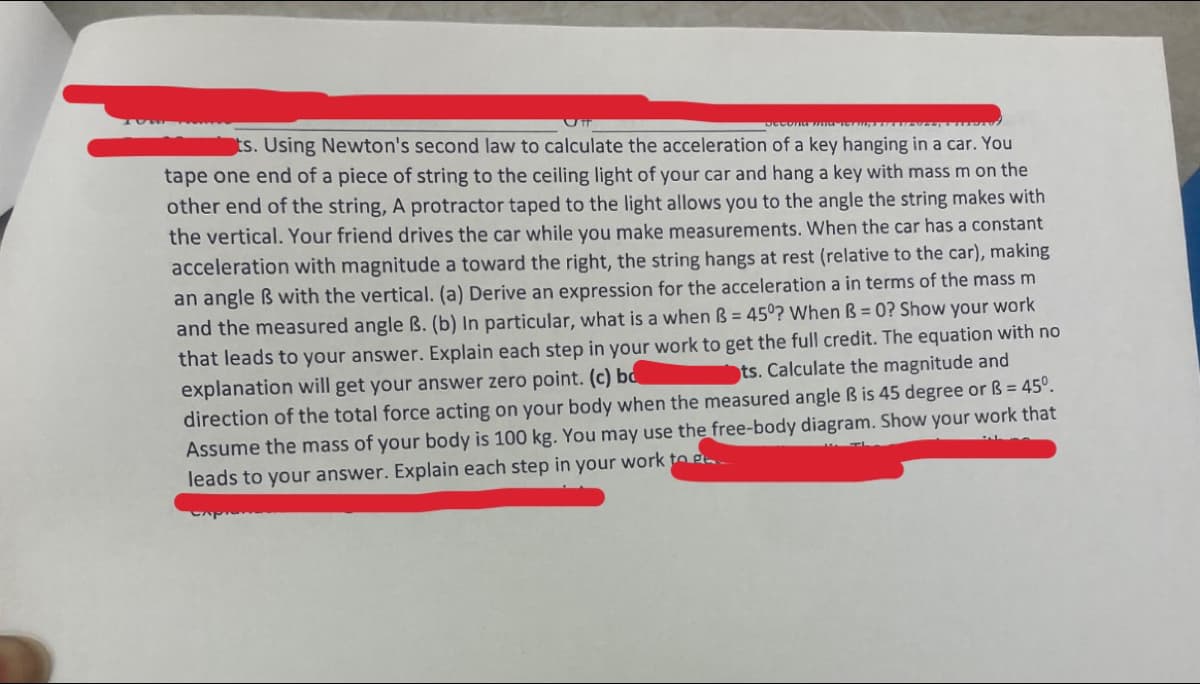DECORE MI ts. Using Newton's second law to calculate the acceleration of a key hanging in a car. You tape one end of a piece of string to the ceiling light of your car and hang a key with mass m on the other end of the string, A protractor taped to the light allows you to the angle the string makes with the vertical. Your friend drives the car while you make measurements. When the car has a constant acceleration with magnitude a toward the right, the string hangs at rest (relative to the car), making an angle ß with the vertical. (a) Derive an expression for the acceleration a in terms of the mass m and the measured angle B. (b) In particular, what is a when B = 45°? When B=0? Show your work that leads to your answer. Explain each step in your work to get the full credit. The equation with no ts. Calculate the magnitude and explanation will get your answer zero point. (c) bo direction of the total force acting on your body when the measured angle B is 45 degree or B = 45°. Assume the mass of your body is 100 kg. You may use the free-body diagram. Show your work that leads to your answer. Explain each step in your work to d
DECORE MI ts. Using Newton's second law to calculate the acceleration of a key hanging in a car. You tape one end of a piece of string to the ceiling light of your car and hang a key with mass m on the other end of the string, A protractor taped to the light allows you to the angle the string makes with the vertical. Your friend drives the car while you make measurements. When the car has a constant acceleration with magnitude a toward the right, the string hangs at rest (relative to the car), making an angle ß with the vertical. (a) Derive an expression for the acceleration a in terms of the mass m and the measured angle B. (b) In particular, what is a when B = 45°? When B=0? Show your work that leads to your answer. Explain each step in your work to get the full credit. The equation with no ts. Calculate the magnitude and explanation will get your answer zero point. (c) bo direction of the total force acting on your body when the measured angle B is 45 degree or B = 45°. Assume the mass of your body is 100 kg. You may use the free-body diagram. Show your work that leads to your answer. Explain each step in your work to d
Physics for Scientists and Engineers, Technology Update (No access codes included)
9th Edition
ISBN:9781305116399
Author:Raymond A. Serway, John W. Jewett
Publisher:Raymond A. Serway, John W. Jewett
Chapter2: Motion In One Dimension
Section: Chapter Questions
Problem 2.2CQ: Try the following experiment away from traffic: where you can do it Safely. With the car VOU are...
Related questions
Topic Video
Question

Transcribed Image Text:Decont M
ts. Using Newton's second law to calculate the acceleration of a key hanging in a car. You
tape one end of a piece of string to the ceiling light of your car and hang a key with mass m on the
other end of the string, A protractor taped to the light allows you to the angle the string makes with
the vertical. Your friend drives the car while you make measurements. When the car has a constant
acceleration with magnitude a toward the right, the string hangs at rest (relative to the car), making
an angle ß with the vertical. (a) Derive an expression for the acceleration a in terms of the mass m
and the measured angle B. (b) In particular, what is a when B = 45°? When B=0? Show your work
that leads to your answer. Explain each step in your work to get the full credit. The equation with no
ts. Calculate the magnitude and
explanation will get your answer zero point. (c) bo
direction of the total force acting on your body when the measured angle B is 45 degree or B = 45⁰.
Assume the mass of your body is 100 kg. You may use the free-body diagram. Show your work that
leads to your answer. Explain each step in your work to a
Capra
Expert Solution
This question has been solved!
Explore an expertly crafted, step-by-step solution for a thorough understanding of key concepts.
This is a popular solution!
Trending now
This is a popular solution!
Step by step
Solved in 2 steps with 1 images

Knowledge Booster
Learn more about
Need a deep-dive on the concept behind this application? Look no further. Learn more about this topic, physics and related others by exploring similar questions and additional content below.Recommended textbooks for you

Physics for Scientists and Engineers, Technology …
Physics
ISBN:
9781305116399
Author:
Raymond A. Serway, John W. Jewett
Publisher:
Cengage Learning

University Physics Volume 1
Physics
ISBN:
9781938168277
Author:
William Moebs, Samuel J. Ling, Jeff Sanny
Publisher:
OpenStax - Rice University

Glencoe Physics: Principles and Problems, Student…
Physics
ISBN:
9780078807213
Author:
Paul W. Zitzewitz
Publisher:
Glencoe/McGraw-Hill

Physics for Scientists and Engineers, Technology …
Physics
ISBN:
9781305116399
Author:
Raymond A. Serway, John W. Jewett
Publisher:
Cengage Learning

University Physics Volume 1
Physics
ISBN:
9781938168277
Author:
William Moebs, Samuel J. Ling, Jeff Sanny
Publisher:
OpenStax - Rice University

Glencoe Physics: Principles and Problems, Student…
Physics
ISBN:
9780078807213
Author:
Paul W. Zitzewitz
Publisher:
Glencoe/McGraw-Hill

An Introduction to Physical Science
Physics
ISBN:
9781305079137
Author:
James Shipman, Jerry D. Wilson, Charles A. Higgins, Omar Torres
Publisher:
Cengage Learning